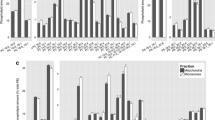Abstract
Phosphatidylcholine, in addition to the widely studied inositol phospholipids, is cleaved to produce second messengers in neuronal signal transduction processes. Because of the difficulty in labelling and measuring the metabolism of endogenous phosphatidylcholine in brain tissue, we investigated the utility of measuring the hydrolysis of exogenous labelled substrate incubated with rat cerebral cortical cytosol and membrane fractions as has been successful in studies of phosphoinositide hydrolysis. In the cytosol [3H]phosphatidylcholine was hydrolyzed at a linear rate for 60 min of incubation and GTPγS stimulated hydrolysis by 63%. The products of phospholipase C and phospholipase D, phosphorylcholine and choline, contributed only 44% of the [3H]phosphatidylcholine hydrolytic products in the cytosol, with phospholipase D activity slightly predominating. GTPγS stimulated cytosolic phospholipase C and reduced phospholipase D activity. [3H]Phosphatidylcholine was hydrolyzed much more slowly by membranes than by cytosol. In membranes the production of [3H]phosphorylcholine and [3H]choline were approximately equal, contributing 27% of the total [3H]phosphatidylcholine hydrolysis, and GTPγS only caused a slight stimulation of phospholipase C activity. Chronic lithium treatment (4 weeks) appeared to slightly reduce [3H]phosphatidylcholine metabolism in the cytosol and in membranes, but no statistically significant reductions were achieved. Cytosol and membrane fractions from postmortem human brain metabolized [3H]phosphatidylcholine slowly, and GTPγS had no effects. In summary, exogenous [3H]phosphatidylcholine was hydrolyzed by brain cytosol and membranes, and this was stimulated by GTPγS, but the complex contributions of multiple metabolic pathways complicates the application of this method for studying individual pathways, such as phospholipase D which contributes only a fraction of the total processes hydrolyzing exogenous [3H]phosphatidylcholine.
Similar content being viewed by others
References
Fisher, S. K., and Agranoff, B. W. 1987 Receptor activation and inositol lipid hydrolysis in neuronal tissues. J. Neurochem. 48:999–1017.
Loffelholz, K. 1989. Receptor regulation of choline phospholipid hydrolysis. Biochem. Pharmacol. 38:1543–1549.
Exton, J. H. 1990. Signalling through phosphatidylcholine breakdown. J. Biol. Chem. 265:1–4.
Claro, E., Wallace, M. A., Lee, H. M., and Fain, J. N. 1989. Carbachol in the presence of guanosine 5′-0-(3-thiotriphosphate) stimulates the breakdown of exogenous phosphatidylinositol 4,5-bisphosphate, phosphatidylinositol 4-phosphate, and phosphatidylinositol by rat brain membranes. J. Biol. Chem. 264:18288–18295.
Wallace, M. A., and Claro, E. 1990. Comparison of serotonergic to muscarinic cholinergic stimulation of phosphoinositide-specific phospholipase C in rat brain cortical membranes. J. Pharmacol. Exp. Therap. 255:1296–1300.
Carter, H. R., Wallace, M. A., and Fain, J. N. 1990. Activation of phospholipase C in rabbit brain membranes by carbachol in the presence of GTPγS; effects of biological detergents. Biochim. Biophys. Acta 1054:129–135.
Song, L., and Jope, R. S. 1992. Chronic lithium treatment impairs phosphatidylinositol hydrolysis in membranes from rat brain regions. J. Neurochem. 58:2200–2206.
Wang, P., Anthes, J. C., Siegel, M. I., Egan, R. W., and Billah, M. M. 1991. Existence of cytosolic phospholipase D. J. Biol. Chem. 266:14877–14880.
Casebolt, T. L., and Jope, R. S. 1991. Effects of chronic lithium treatment on protein kinase C and cyclic AMP-dependent protein phosphorylation. Biol. Psychiat. 29:233–243.
Jenden, D. J., Roch, M. and Booth, R. A. 1973. Simultaneous measurement of endogenous and deuterium labelled tracer variants of choline and acetylcholine in subpicomole quantities by gas chromatography mass spectrometry. Anal. Biochem. 55:438–448.
Qian, Z., Reddy, P. V., and Drewes, L. R. 1990. Guanine nucleotide-binding protein regulation of microsomal phospholipase D activity of canine cerebral cortex. J. Neurochem. 54:1632–1638.
Kanoh, H., Kanaho, Y., and Nozawa, Y. 1991. Activation and solubilization by triton X-100 of membrane-bound phospholipase D of rat brain. Lipids 26:426–430.
Liscovitch, M. and Eli, Y. 1991. Ca2+ inhibits guanine nucleotide-activated phospholipase D in neural-derived NG108-15 cells. Cell Regulation 2:1011–1019.
Nahorski, S. R., Ragan, C. I., and Challiss, R. A. J. 1991. Lithium and the phosphoinositide cycle: an example of uncompetitive inhibition and its pharmacological consequences. Trends Pharmacol. Sci. 12:297–303.
Brami, B. A., Leli, U., and Hauser, G. 1991. Influence of lithium on second messenger accumulation in NG108-15 cells. Biochem. Biophys. Res. Commun. 174:606–612.
Author information
Authors and Affiliations
Rights and permissions
About this article
Cite this article
Song, L., Baird, M.S. & Jope, R.S. Hydrolysis of exogenous [3H]phosphatidylcholine by brain membranes and cytosol. Neurochem Res 18, 1305–1311 (1993). https://doi.org/10.1007/BF00975052
Received:
Issue Date:
DOI: https://doi.org/10.1007/BF00975052




